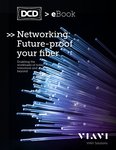Last year, the UK government published its 2022 Digital Strategy with a heavy focus on positioning the country as a ‘Global Science and Tech Superpower’.
Not a bad idea when you consider that, according to a report by Public First, digital technology could grow the UK economy by over £413 billion ($524bn) by 2030. There is, however, a lot of work that needs to be completed before reaching that point.
One of the biggest requirements for the UK’s digital transformation is an upgrade of its digital infrastructure, which is needed to accommodate ever-increasing data demands.
New technological advancements – such as 5G, machine learning, and artificial intelligence – are being incorporated into the likes of smart networks, advanced manufacturing, and autonomous transport, with almost limitless potential. But for these technologies to work efficiently, nationwide high-speed connectivity must be available.
These demands, amongst other factors, have led to a jump from a 100Gbps infrastructure to 400Gbps, somewhat bypassing the 200Gbps milestone.
The issue there is that the previous speeds all used Non-Return-To-Zero (NRZ) modulation, which can’t process 400Gbps speed. This necessitates the use of a completely different type of modulation.
The incompatibility issue
To achieve the faster data speeds of 400Gbps, more data needs to be transmitted down the cable at the same time, which is where Pulse Amplitude Modulation 4 Level (PAM4) comes into play.
While NRZ modulation uses two voltage levels to represent binary data (with one level representing a ‘0’ and the other representing a ‘1’), PAM4 uses four different voltage levels (representing ‘0-0’ ‘0-1’ ‘1-0’ and ‘1-1’).
This allows PAM4 to transmit twice as much data in each clock cycle, with each voltage level representing two bits of data instead of one, effectively doubling the rate of data being passed over the same physical medium.
Having these two distinct modulation schemes in place, however, means that they can’t interoperate. PAM4’s four-level system won’t be understood by equipment designed to read the two-level system of NRZ, and vice versa.
Therefore, for network operators looking to upgrade to 400Gbps, they need to ensure that both ends of a link are using the same modulation.
This issue really comes into effect when using breakout cables (e.g. breaking out 400Gbps into 4 x 100Gbps links) as most of the 100Gbps optics in today’s networks are running NRZ modulation and are therefore incompatible.
Users would, therefore, need to change their 100Gbps optics to ones using PAM4 modulation, assuming the device the optics are inserted into has been certified to work with PAM4-100Gbps optics.
Not all of these issues are insurmountable, however, it is another factor that network architects and engineers need to consider before jumping in and upgrading their networks.
The cost of moving to 400Gbps
Due to the incompatibility between PAM4 and NRZ, anyone looking to start using 400Gbps will need to consider replacing their existing transceivers. 400Gbps transceivers are expensive, as is often the case with new technology, and whilst it is true that the price will eventually come down, customers need to be aware that they won’t be as cost-effective as the older transceivers.
There are two reasons for this. Firstly, these new transceivers need to maintain compatibility with existing Quad Small Form-factor Pluggable (QSFP) form factors and, as such, they need to fit into the same physical space as the previous, NRZ-based transceivers.
Developing a transceiver that is able to transmit and receive PAM4 signals, while keeping the size the same as previous transceivers, involves considerable costs – making the new transceivers more expensive.
Secondly, the 400Gbps transceivers generate more heat than their 100Gbps counterparts. As the size of a transceiver is the same, there is more heat to disperse, increasing the risk of the transceiver becoming distorted.
Not only does this add to the cost of research and development, with additional testing required to understand the temperature thresholds, but it also means that further investment is needed in cooling and power infrastructures.
Understanding the requirements before upgrading
The move from 10Gbps to 40Gbps to 100Gbps was relatively easy as they all (for the most part) used the same modulation.
This means that the use of breakout cables to split or combine different speeds worked well, providing us with a simple route to move between speeds which eased the migration. With the move to PAM4, we just need to work out what can and can’t interoperate.
There is, of course, an eagerness to upgrade to 400Gbps networks. But before starting, it is important to understand exactly what is required for a 400Gbps transmission to work and how much it is going to cost.
As we transition to higher speeds, it’s no longer just about considering the type of fibers being used (single mode or multimode) and the transmission length of a particular technology.
We must also consider how devices capable of running at these faster speeds are going to interoperate with existing networks.
Network operators that recognize these challenges can avoid costly mistakes and make the most efficient use of the resources, not only now, but also during future upgrades – as it is highly likely we will run into similar challenges when upgrading to 800Gbps, or even 1.6Tbps, networks.








